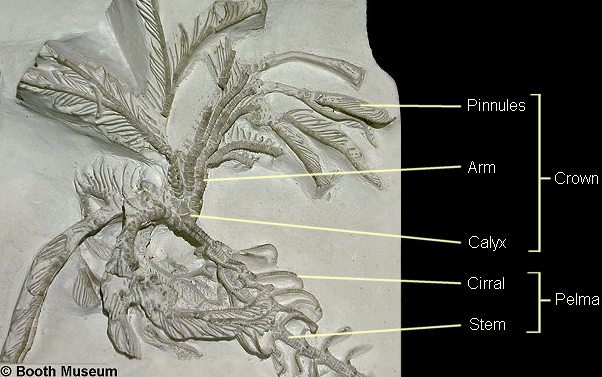|
|
 B B |
|
CRINOID TERMINOLOGY |
The iconic Crinoid body plan is superficially plant-like, hence the common name of sea-lilies. A radiating crown is mounted upon an elongate stem which terminates in a branching root system (radix). However, a significant portion of the Chalk fauna lack a stem, and either rested on the seafloor or were free swimming.
|
|
 B B |
1). (A) Living crinoid; (B) Fossil crinoid. The living animal's posture is instructive as to it's mode of life. The stem positions the umbrella-like crown aloft in the water column and tilts it in the direction of the currents, allowing it to gather nutrients. The crown is composed of a cup-like calyx, which encloses the body cavity, and five radiating arms. The arms are often branched, and bearing small branchlets known as pinnules. A cilia-lined groove (ambulacra) runs the length of each arm and delivers food particles to the mouth which is situated on the upper surface of the calyx. Both the mouth and the anus are openings in the skin-like tegmen which is stretched across the top of the calyx. Branches of the hydraulic water-vascular-system run the length of the arms and bear small extensions known as tube-feet, used in respiration. The stem bears extensions known as cirri which can be used in conjunction with the root system (radix) to anchor the crinoid. The stem is comprised of stacked ossicles referred to as columnals. Cirri branch from specialised columnals called nodals. The stem, cirrals and radix combined comprise the pelma. ((A) ~ x0.5, image used courtesy of Dave Liddell, Utah State University (Geology of Northern Utah)); ((B) Jurassic crinoid (Apiocrinites sp.), partly reconstructed individual, x0.4, Bathonian, Bradford Clay(?), Bradford (?), BMNH (British Museum (Natural History) London), no specimen number. Image © 2005 The Natural History Museum, by kind permission).

2). Chalk crinoid (Isocrinus? granosus). ((x1.0) Image courtesy of the Booth Museum, by kind permission of John Cooper).
|
|
 B B |
3). Chalk crinoids (Isocrinus? granosus) (x5.4). (A) Isolated stem section, clearly comprised of stacked columnals. (B) The articulating surface of an ioslated columnal.